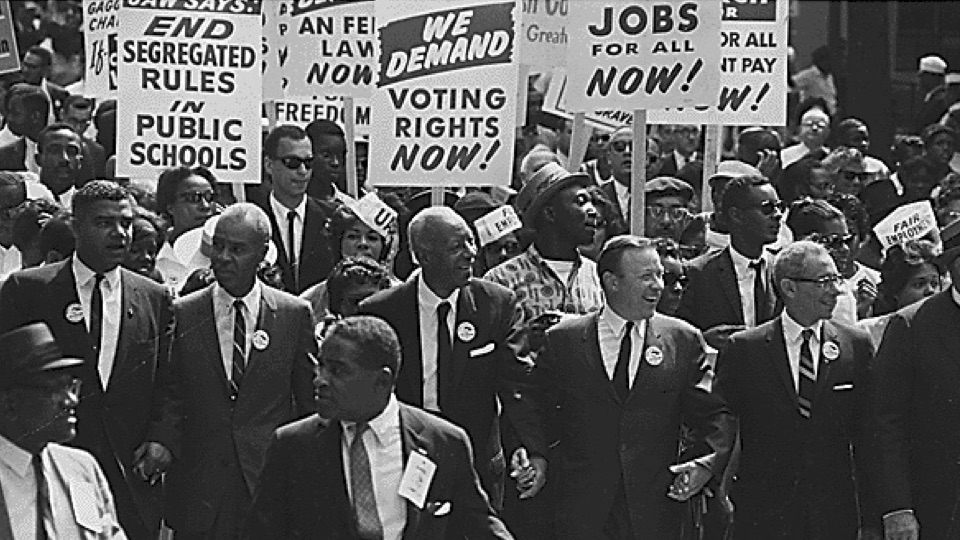One of our most precious rights as Americans is the ability to freely express our opinion, whether it be on a blog, a letter to the Editor of our local newspaper…or in a song.
Practically everyone can name a song (or two) that’s been tagged as one defining an era. However, not all fall into the category of favorite romantic ballad or favored dance track; national and global events have sparked artists to record impassioned pleas for awareness, via song or rap. These protest songs have the unique ability to move some to tears — and others to action. They become battle cries sung at demonstrations or marches and frequently establish their place in history.
Related: “D.A. Pennebaker: The Eye of the Counterculture”
Case in point, the Vietnam War era yielded several protest anthems. Most notably, “War” by Edwin Starr and John Lennon’s “Give Peace a Chance.” Known more for ballads like “Oh Girl” and “Have You Seen Her,” the Chi-lites broke tradition and struck a nerve with “(For God’s Sake) Give More Power to the People.” The smash-hit took aim at the government and rich folks lining their pockets with cash during a time of economic injustice.
In an appeal for peace and tolerance, lyrics from The Byrd’s “Turn! Turn! Turn!” were nearly taken verbatim from the Bible’s Book of Ecclesiastes:
To everything, there is a season and a time to every purpose under the heaven
A time to be born, and a time to die; a time to plant, a time to reap that which is planted
A time to kill, and a time to heal; a time to break down, and a time to build up
A time to weep, and a time to laugh; a time to mourn, and a time to dance…
Perhaps the mother of all social awareness anthems captured on an entire piece of vinyl is Marvin Gaye’s classic What’s Going On. The album’s beautifully haunting songs serve as narratives on inner-city woes, vets returning home from Vietnam, hatred, injustice, poverty, drug abuse, and even ecological concerns. The genius of Gaye is that much of those heart-tugging lyrics and music written 50 years ago still apply to current events.
With the nation being turned on its axis by so many issues, some of today’s artists have picked up the mantle to lend their voices. More and more are stepping up to the mic to give expression through song. The Killers’ “Land of the Free” touches on everything from racism to gun violence to immigration. Alicia Keys’ “Perfect Way to Die” will appear on her self-titled album Alicia due for release in the fall. Keys explains that the song was written from the point of view of a mother whose child has been murdered.
Kora Feder wrote and recorded “In a Young Person’s Body” while holed up in her Philadelphia apartment during the initial weeks of the COVID-19 pandemic. LL Cool J unleashed an untitled 2 ½-minute rap addressing the nation’s tensions via Instagram on June 1.
It has been said that the idiom music calms the savage beast is often misquoted, but right now we all can do with some calming, some soothing, some hope even if the lyrics dare challenges us to leave our various comfort zones and face harsh realities. Protest music can be a very powerful tool and it certainly had its impact during the ’60s and ’70s. Time will only tell which, if any, new songs will rise to such an occasion and become a clarion call for such a time as this.
-Sharon Oliver
Photo: March on Washington, 1963 (Wikimedia Commons)




Sharon, I love this.
The idea that “protest songs” started in the ’60s completely ignores the fact that countless protest songs — or tunes with pointed social or political lyrics — were created in the decades before then. This includes everything from tunes by Jimmie “The Singing Brakeman” Rogers, Billie Holiday and Woody Guthrie to Spike Jones’ “Der Fuehrer’s Face.” How many “protest songs” became hits in the 1960s? Actually, not that many — as they were vastly crowdeed out in popularity by the perpetual #1 theme in popular music: romance. If you actually analyze it, nearly every hit in every decade is, in reality, an emotional snapshot taken at one point or anothe along a romantic adventure. . .
Great article. Thanks for writing.
Good article. I think that song “I just Wanna Live” by 12-year-old Keedron Bryant will be at least one of the definitive songs of the present day angst.
Excellent reading.
[…] Songs reflecting social/cultural upheaval are among some of the most powerful American music. We take a look at some classics — and new ones on the rise. — Read on http://www.culturesonar.com/the-history-power-and-popularity-of-protest-songs/ […]